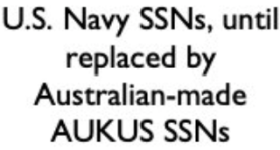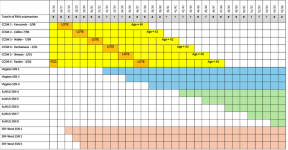The landmark defense agreement between the U.S, U.K. and Australia could be in jeopardy with the maverick Republican back in the White House.
LONDON — There are few issues on which we do not know Donald Trump’s opinion.
After thousands of hours of interviews and speeches over the past eight years, the president-elect has enlightened us on what he thinks on almost any topic which enters his brain at any given moment.
But in the key area of defense, there are some gaps — and that's leading global military chiefs to pore over the statements of the president's allies and appointees to attempt to glean some clues, specifically over the $369 billion trilateral submarine program known as AUKUS he will inherit from Joe Biden.
Trump does not appear to have publicly commented on the AUKUS pact — named for its contingent parts Australia, the United Kingdom and the United States — which would see the U.S. share technology with its partners to allow both countries to build state-of-the-art nuclear submarines by the 2040s.
This uncertainty has left ministers and government officials in London and Canberra scrambling to discover how the Republican is likely to view the Biden-era deal when he returns to the White House in January.
Two defense industry figures told POLITICO there were serious concerns in the British government that Trump might seek to renegotiate the deal or alter the timelines.
This is because the pact likely requires the U.S. to temporarily downsize its own naval fleet as a part of the agreement — something Trump may interpret as an affront to his “America First” ideology.
Looking east
There is hope in Westminster that Trump would be in favor of a military project which is an obvious, if unspoken, challenge to China.
The deal would see American-designed nuclear submarines right on China's doorstep and would form a part of Australia's attempts to bolster its military might in the Indo-Pacific.
When former U.K. Prime Minister Boris Johnson
said in September 2021 that the deal was not "intended to be adversarial toward China," President Xi Jinping simply did not believe him.
The Chinese leader
said AUKUS would "undermine peace" and accused the Western nations of stoking a Cold War mentality.
Mary Kissel, a former senior adviser to Trump's ex-Secretary of State Mike Pompeo, said "you can assume Trump two will look a lot like Trump one" when it comes to building alliances with other Western countries against China.
"We revivified the Quad [Australia, India, Japan and the U.S.], got our allies to bolster NATO funding and worked to prevent China from dominating international institutions," she said.
However, the deal also forces the U.S. government to sell Australia three to five active Virginia attack submarines, the best in the U.S. Navy's fleet, by the early 2030s as a stopgap until the new AUKUS subs are built.
Is America first?
This coincides with a time where there is a
widely recognized crunch on America's industrial defense capacity.
In layman's terms, the U.S. is currently struggling to build enough submarines or military equipment for its own needs.
One U.K. defense industry figure, granted anonymity to speak freely, said there was “a lot of queasiness” in the U.K. government and a “huge amount of queasiness in Australia” about whether Trump would allow this to happen.
“There is a world in which the Americans can't scale up their domestic submarine capacity for their own needs and don't have spare to meet Australia's needs,” they said.
“If you started pulling on one thread of the deal, then the rest could easily fall away.”
One U.K. government official played down how much London and Canberra are worried about the future of the deal, however.
They said the U.K. government was confident Trump is positive about the deal and that the U.S. was “well equipped with the number of submarines for their fleet.”
Glimmers of hope
In Washington too, defense experts are seeking clues to the attitude of the incoming administration.
While close observers agree it is too soon to predict what Trump would do about AUKUS, there has been some reason for optimism in the president-elect’s selection of two China hawks for top national security posts: Sen. Marco Rubio (R-Fla.), as secretary of state, and Rep. Mike Waltz (R-Fla.) as national security adviser.
Both served on the congressional foreign affairs committees that handled legislation to authorize AUKUS and will be well aware that it has broad bipartisan support in the U.S. Congress, giving AUKUS advocates on Capitol Hill two well-placed former colleagues with whom they can make their case to Trump world.
But the brightest glimmer of hope may be an Economist essay Waltz co-authored last month that slams Biden and Vice President Kamala Harris for a rash of global crises, but reserves a some praise for AUKUS.
“Mr. Biden and Ms. Harris have taken some positive steps on China, such as strengthening export controls and establishing AUKUS, a trilateral security partnership with Britain and Australia, but these have been more than outweighed by the distraction caused by failed policies in Europe and the Middle East,” Waltz wrote with Matthew Kroenig, a former Pentagon strategist.
Meanwhile, a U.K. review into the entire AUKUS project is being led by Stephen Lovegrove, former national security adviser to Boris Johnson, after being commissioned by Defence Secretary John Healey in August.
Lovegrove was supposed to release the report in October, but it has still not been published.
Feeling queasy
However, Alexander Gray, a national security-focused White House aide in Trump's first term, told POLITICO that there was good reason for the aforementioned queasiness.
The former chief of staff to Trump's National Security Council said “we need to have a serious discussion given the demands on U.S. Navy attack submarine fleet,” adding that “we’re not on track to reach the minimum requirements for our own needs.”
“If you take America first literally, and people should, then you should not be surprised if a serious American defense official comes and says ‘we have to prioritize construction or repair needs for our own purposes,’” Gray added.
“That doesn't question the validity of AUKUS, or mean it’s not a priority, but we need to start looking at these commitments in an American-centric way that may not meet up with the priorities of Canberra and London.”
Gray also savaged Keir Starmer for his decision to meet with President Xi just days after Trump's reelection, labeling the British prime minister's attempts to improve Sino-British relations as “regrettable.”
“One of the successes of Trump’s term, and the Biden-Harris administration, was a significant amount of mutual understanding of partners in London and Europe writ large about the danger China poses globally,” he said.
“I hate to see backsliding like this at the very start of a `Trump administration.”
Everyone's a winner
This attempted U.K.-China reset will likely be high on the list of talking points when Healey meets with his Australian counterpart Richard Marles next month in London for an “AUKMIN” summit.
The Australian Labor government, after all, has conducted a similar reset with the Chinese government since coming to power in 2022 after relations hit a nadir during COVID.
Also at the top of the agenda will be how to sell the incoming president on the AUKUS deal in a positive way.
A second defense industry insider said the British and Australian governments should try to badge the deal in terms that make it look like Trump has personally won from the deal.
“Everybody is worried about America's lack of industrial capacity and how it affects AUKUS,” they said.
“He is also instinctively against the idea of America being the world’s police and so he may not see the value in AUKUS at all, but they need to let him own it and make him think he’s won by doing it.”
Sophia Gaston, the London-based U.K. foreign policy lead at Canberra's ASPI think tank, said most people in Trump's orbit “can find some element of the project which chimes with their interests.”
“Britain and Australia need to work in complete lockstep on AUKUS in Washington, and recognize that they must embrace more tactical and strategic language grounded in American self-interest,” she said.
“There will also be a need to demonstrate how AUKUS can deliver short-term wins, which ensure the project’s deterrence effect is credible.”
Pillar II
While the core nuclear submarine deal will get most of the headlines in the coming months, progress on the lesser-known Pillar II of AUKUS also remains somewhat elusive.
Launched alongside the submarine pact, Pillar II was designed to codevelop a range of military technologies, such as quantum-enabled navigation, artificial intelligence-enhanced artillery, and electronic warfare capabilities.
One Pillar II technology-sharing deal was struck on hypersonic missiles just last month, but expected progress on a range of other areas has not transpired.
Ambitions to admit Japan to the Pillar II partnership this year have also gone unfulfilled.
Meanwhile, there seemed to be a step forward when the Biden administration introduced legislation to ease the trade of sensitive technology between the three nations earlier this summer.
But while it was dubbed “a historic breakthrough” by the U.K., pro-Trump Sen. Jim Risch, the most senior Republican on the U.S. Senate Foreign Relations Committee, complained it was “overly restrictive” and limited progress on AUKUS Pillar II.
“I couldn't be more dissatisfied with the pace of implementation,” he said. “It is not moving at the speed of relevance.”
However, some U.S. policy wonks are somewhat more optimistic about the future of the program.
Bryan Clark, director of the Center for Defense Concepts and Technology at the Hudson Institute, said Trump might channel some funds from Pillar I into Pillar II.
He said: “Can we siphon some of that money off to support Pillar II, because it gives us a faster benefit?
“The tech startup community is going to be entering the administration in official and unofficial positions, so I think we’ll find their influence will protect some of these investments.”
There surely won't be long to wait until the president-elect comes down from on high to give his opinion on AUKUS.
All interested parties will no doubt be watching X and Truth Social for when that moment arrives.













